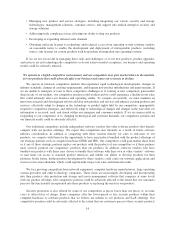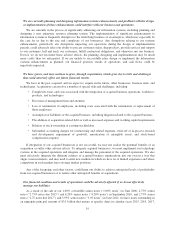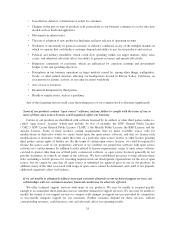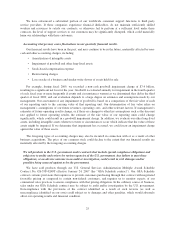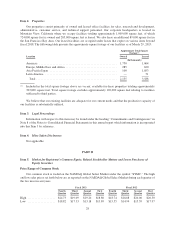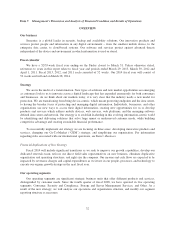Symantec 2013 Annual Report Download - page 120
Download and view the complete annual report
Please find page 120 of the 2013 Symantec annual report below. You can navigate through the pages in the report by either clicking on the pages listed below, or by using the keyword search tool below to find specific information within the annual report.If we do not protect our proprietary information and prevent third parties from making unauthorized use of
our products and technology, our financial results could be harmed.
Most of our software and underlying technology is proprietary. We seek to protect our proprietary rights
through a combination of confidentiality agreements and procedures and through copyright, patent, trademark,
and trade secret laws. However, all of these measures afford only limited protection and may be challenged,
invalidated, or circumvented by third parties. Third parties may copy all or portions of our products or otherwise
obtain, use, distribute, and sell our proprietary information without authorization.
Third parties may also develop similar or superior technology independently by designing around our
patents. Our shrink-wrap license agreements are not signed by licensees and therefore may be unenforceable
under the laws of some jurisdictions. Furthermore, the laws of some foreign countries do not offer the same level
of protection of our proprietary rights as the laws of the U.S., and we may be subject to unauthorized use of our
products in those countries. The unauthorized copying or use of our products or proprietary information could
result in reduced sales of our products. Any legal action to protect proprietary information that we may bring or
be engaged in with a strategic partner or vendor could adversely affect our ability to access software, operating
system, and hardware platforms of such partner or vendor, or cause such partner or vendor to choose not to offer
our products to their customers. In addition, any legal action to protect proprietary information that we may bring
or be engaged in, alone or through our alliances with the Business Software Alliance (“BSA”), or the Software &
Information Industry Association (“SIIA”), could be costly, may distract management from day-to-day
operations, and may lead to additional claims against us, which could adversely affect our operating results.
In January 2012, we became aware of disclosure of the source code for 2006-era versions of certain of our
Norton and pcAnywhere products, which we believe was the result of a theft of source code that occurred in
2006. Any unauthorized disclosure of a significant portion of our source code could result in the loss of future
trade secret protection for that source code. This could make it easier for third parties to compete with our
products by copying functionality, which could adversely affect our revenue, operating margins, results of
operations and cash flows, as well as our reputation. Unauthorized disclosure of our source code also could
increase the security risks described under “Our software products, SaaS Offerings and website may be subject to
intentional disruption that could adversely impact our reputation and future sales” below.
From time to time we are a party to class action and other lawsuits, which typically require significant
management time and attention and result in significant legal expenses, and which could, if not determined
favorably, negatively impact our business, financial condition, results of operations, and cash flows.
We have been named as a party to class action lawsuits, and we may be named in additional litigation. The
expense of defending such litigation may be costly and divert management’s attention from the day-to-day
operations of our business, which could adversely affect our business, results of operations, and cash flows. In
addition, an unfavorable outcome in such litigation could result in significant monetary damages or injunctive
relief that could negatively impact our ability to conduct our business, results of operations, and cash flows.
Third parties claiming that we infringe their proprietary rights could cause us to incur significant legal
expenses and prevent us from selling our products.
From time to time, we receive claims that we have infringed the intellectual property rights of others,
including claims regarding patents, copyrights, and trademarks. Because of constant technological change in the
segments in which we compete, the extensive patent coverage of existing technologies, and the rapid rate of
issuance of new patents, it is possible that the number of these claims may grow. In addition, former employers
of our former, current, or future employees may assert claims that such employees have improperly disclosed to
us the confidential or proprietary information of these former employers. Any such claim, with or without merit,
could result in costly litigation and distract management from day-to-day operations. If we are not successful in
defending such claims, we could be required to stop selling, delay shipments of, or redesign our products, pay
monetary amounts as damages, enter into royalty or licensing arrangements, or satisfy indemnification
22




